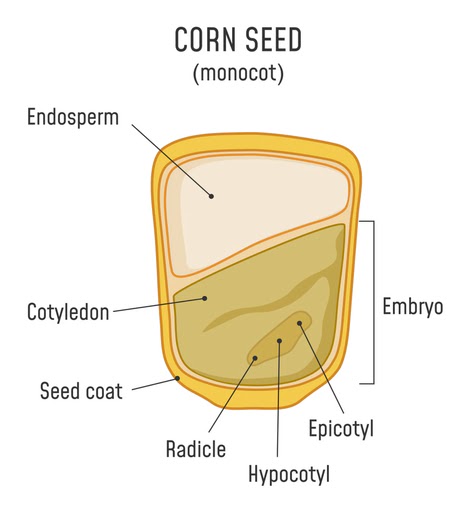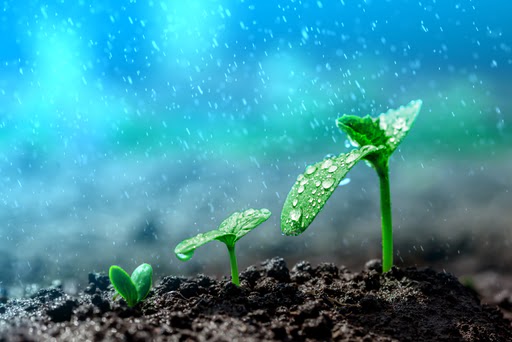Seeds develop into larger plants through the process of germination. Germination requires the optimal amount of sunlight, temperature, water, and air for the seed to transform into a plant.
Isn’t it fascinating that a seed, which is so small, can give rise to a towering tree? Just like a human embryo contains all the genetic material that determines our growth into adults, the embryo in a seed performs the same function!
Mother Nature is truly remarkable and knows precisely when the seed is ready to grow; when the conditions are not ideal, it delays its development during seed dormancy. A seed is produced by the plant through sexual reproduction, but let’s explore what happens next!
The Structure of a Seed
A seed consists of three main parts:
- The Embryo – it gives rise to the new plant.
- The Endosperm – it nourishes and provides food for the seedling.
- The Seed Coat – the tough outer layer that protects the embryo. Some seed coats are hard (like peas and corn), while others are relatively soft (like tomatoes and peppers).
 Structure of a corn seed (Photo Credit: Fancy Tapis/ Shutterstock)
Structure of a corn seed (Photo Credit: Fancy Tapis/ Shutterstock)
Germination Process and its Requirements
Germination is the process of a seed transforming into a seedling, which requires optimal sunlight, air, and water. The seed can only grow within a specific temperature range, and temperatures outside of this range can either damage the seeds or make them dormant.
The seed coat has small holes or pores that allow water and air to enter. Like any living organism, the seed needs oxygen and releases carbon dioxide until the leaves grow and start producing oxygen. The soil must be porous to allow water and air to reach the seed.
If the soil is not porous, carbon dioxide cannot leave the seed, leading to suffocation. If the conditions are ideal, the seed absorbs more water, swells up, and eventually bursts!
Once the seed coat bursts open, a primary root called the radicle emerges. In most plants, the root appears before the shoot, although there are exceptions like coconuts where the shoot emerges before the root. The root then absorbs water and nutrients from the soil, taking over the function previously performed by the seed coat.
Seed Nutrition before Leaf Growth
Plants are the primary producers in the food chain because they have chlorophyll in their leaves, which enables photosynthesis and food production.
However, a seed that has not yet grown leaves relies on the starch stored in its cotyledons for survival. Even after the seed bursts, the root and cotyledons remain while the seed coat falls off and detaches from the plant. The cotyledons continue providing nourishment to the young plant until the leaves emerge and can produce their own food.
 A diagram illustrating the process of germination (Photo Credit: Designua/ Shutterstock)
A diagram illustrating the process of germination (Photo Credit: Designua/ Shutterstock)
After the root, the hypocotyl and epicotyl grow upwards to form the stem, with the epicotyl developing into the plant’s first leaves. When the epicotyl emerges, the stem reaches above the ground, and the leaves start to grow. At this point, the cotyledons fall off as their purpose is fulfilled, and the plant can sustain itself through photosynthesis. This completes the germination process. Different seeds have varying requirements for growth, such as water or light.
Seed Dormancy
Seed dormancy refers to the period during which a seed does not germinate, even under optimal conditions. This staggered germination pattern is a mechanism to prevent herbivores from consuming all the plants at once and to avoid the spread of viruses among plants.
Plants, like humans, have hormones that regulate their development. Our hormones, for example, activate during puberty when we transition into adulthood. Similarly, plants have hormones called abscisic acid, which inhibits germination, and gibberellin, which ends seed dormancy.
What Causes Variation in Germination Time for Different Seeds?
 Not all seeds are the same; they vary in characteristics such as shape, size, color, and survival requirements. The time it takes for a seed to germinate can also differ. Some seeds have a tougher outer coat that needs more time to soften before it can burst open. These seeds require more water absorption to soften the coat, which slows down the germination process.
Not all seeds are the same; they vary in characteristics such as shape, size, color, and survival requirements. The time it takes for a seed to germinate can also differ. Some seeds have a tougher outer coat that needs more time to soften before it can burst open. These seeds require more water absorption to soften the coat, which slows down the germination process.
In certain seasons like autumn and winter, when the soil is too cold, seeds become dormant and only germinate in spring or winter. If a seed is planted too deep, it uses up all its energy and stored food in the cotyledon before the shoot can emerge from the soil. Insufficient watering of the soil can cause the seed to dehydrate and die. On the other hand, excessive water can lead to suffocation and death due to lack of oxygen.
Any conditions that fall outside the optimum range can result in the death of the seed. Each seed carries a tremendous responsibility to grow into a towering tree or a life-giving plant, so all the ideal conditions must be met. It seems that humans aren’t the only ones who can be a bit demanding!
